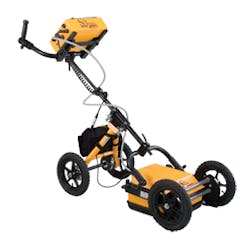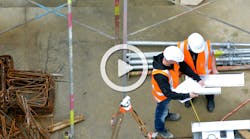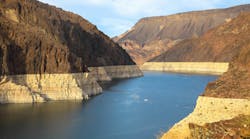When discussing underground utility work, one issue consistently comes to the surface-that of a significant variability in the knowledge levels, skills, and abilities of the utility work force. Certainly this might be said of almost any industry. Where the underground job site is concerned, however, there are big risks and very little room for error. With that said, the obvious imperative is establishing a work culture that puts safety first. This is a top-down initiative that involves a deep commitment to safety compliance and training at every level of an operation.
The Seeker SPR from US Radar is a sub-surface penetrating radar system.
From a positive standpoint, it’s evident that a good number of utility contracting companies have exemplary safety cultures. Often these quality-driven organizations are active in a variety of safety initiatives and training programs affiliated with associations such as the National Utility Contractors Association (NUCA), the Utility Safety & Ops Leadership Network (USOLN), and the Utility Workers Union of America (UWUA).
Association Safety Programs
Consider that on behalf of its more than 10,000 members, the UWUA recently conducted a National Pipeline Safety Forum in the nation’s capital. Its 2011 report outlines an approach to implementing a safety culture that depends on the active engagement of employees, both management and labor, acting as independent and fully equal partners in learning lessons from safety events through a root cause analysis that identifies systemic risks and eliminates them. This approach, they contend, requires a commitment to fully staffing surveillance, patrol, assessment, operating, and maintenance activities to eliminate factors that affect judgment-such as fatigue or pressure to reduce time spent on tasks-and factors that induce inadequate compliance with procedures-such as poor planning and corner cutting-both of which are all-too common amidst the ongoing budget reduction hysteria. Importantly, the UWUA report stresses the need for integral hazard mapping and a forward-looking plan that strengthens accountability and measures progress in eliminating and mitigating identified hazards. Proper safety planning alters the perspective from a reactive response to past disasters to a proactive prevention of further disasters. According to the report, “one must move the safety demarcation line away from the brink, before things break.”
USOLN describes itself as a membership organization which serves as an advocate for a safe, secure, and productive utility work environment and as a catalyst for the prevention of incidents. It provides utility companies and their contracting partners with a reliable Certified Utility Safety Professional (CUSP) certification program, legislative and regulatory updates, and networking resources. USOLN says that CUSP Certification is the only program that offers utility-specific safety leadership credentials. The organization offers a two-day Utility Safety Leadership review program for groups of 20 or more, taught by an approved instructor who will come to a contractor’s facility. A two-hour proctored CUSP exam will follow the class. Those wishing to take the exam must apply and be approved by the USOLN board. Organizations are encouraged to include their contractor partners and other utilities in the region, as this is the most effective process for getting frontline employees and managers on their way to achieving CUSP certification.
NUCA is now accepting applications for the 2012 NUCA Instructor Train-the-Trainer programs, which are tentatively scheduled for April 20, 2012. NUCA currently offers training for both the Excavation Safety & Competent Person and Confined Space Entry programs. The Competent Person training is a two-and-a-half-day program, and Confined Space Entry is a one-and-a-half-day program. To qualify as a NUCA instructor, applicants must have experience in the construction industry, be an OSHA instructor or possess a strong knowledge of OSHA standards, have had prior experience instructing classes or groups, and be willing to make a commitment to the industry. Note that NUCA membership is required before attending the class; or the applicant must be sponsored by and working for a NUCA member in good standing.
NUCA Vice President of Safety George Kennedy says that contractors should know as much about a job site as they can before bidding so that they can adequately prepare a safety plan that prevents worker injury or damage to underground facilities. He stresses that, after a locate request has been called in, one should consider having the project manager or foreman meet the locator at the job site to explain the plan and walk the areas that will be excavated. If a job-site meeting cannot be arranged, at least white-line the proposed excavation before the locator arrives. This will generally result in an improved mark out.
Kennedy also points to the fact that accidents don’t always result in injury or property damage, but that many accidents are close calls, commonly known to safety professionals as “near misses.” He says that these near misses happen all too frequently and are often overlooked; however, the information that can be collected from them is valuable and can be used for training purposes, or to improve safety procedures, or to create a job hazard analysis. The purpose should be to collect information to prevent further occurrences and not to fix blame. He adds that managers should investigate any and all near misses as each may indicate a key safety program deficiency.
On a Safety Mission
Petticoat-Schmitt Civil Contractors builds water, wastewater and stormwater projects, roadway projects, and site development projects in the northeastern Florida and southeastern Georgia markets. The utility work it constructs includes lift stations, sanitary sewer, force main, potable water systems, fire protection systems, and stormwater systems.
Ryan Schmitt serves as president of Petticoat-Schmitt Civil Contractors. He has more than 20 years experience in the construction industry and is the 2011 chairman of the National Utility Contractors Association.
He outlines the company’s safety mission, which involves considerable strategic planning.
Schmitt says that safety is engrained in every aspect of his company. “It started as a main component of our business plan prior to work ever starting, and it is addressed every day we work. We set long-term, annual, and short-term safety goals. Our success is determined by the success of our safety program and ultimately our safety results. One of our safety goals is to continually drop our Workers’ Comp experience modifier. We feel that this is a good benchmark by which to measure our safety success as well as save the company money in workers’ comp premiums. We also like the more visual safety goals. Each year, we strive to win our industry’s most prestigious national safety award, the William H. Feather Safety Award. NUCA awards the nation’s best companies (broken down by size) for their safety performance. We were the proud winners in 2009 and were honorably mentioned in 2010. We continually strive to win this award, and everyone in our company knows it. We are all excited when we win, and it’s truly a team award.”
To keep the company’s focus fresh and exciting, Schmitt says that each year, they try a different safety initiative. “Last year, we had a “˜10-in-10′ campaign, where we would visit job sites and have a 10-minute break to discuss the topics of the OHSA 10-hour course that all our managers had attended earlier in the year. This year our safety campaign is “˜BTB, or back to basics.’ We are focusing on the everyday things that are essential for a good safety program-such as a clean work site, organized and maintained tools, subcontractor compliance, trench safety, maintenance of traffic, and more. All of these issues are being addressed as if we were staring over with our safety program.”
The focus is on daily safety plans, he says, each day starting with a “job briefing” that covers a hazard analysis of the day’s activities. “We talk about these hazards and discuss how they can best be eliminated or avoided. Job briefings are also done during the day if the work activity changes.”
Training is continually emphasized. “It all starts with an informative safety orientation when an employee joins our company. We also conduct CPR/First aid, competent person, confined space, OSHA 10-hour and M.O.T. as formal training classes. Plus, we do informal training in pipe saw usage, trench safety, slip-trip-and-falls, utility locates, and more,” says Schmitt.
One of the most important things about safety, says Schmitt, is awareness. “It’s not difficult for a work force to become complacent and relax safety standards, so you must prevent this by keeping up safety awareness every day. We work hard every day to build our safety culture and maintain a high level of awareness. Since we have a strong culture of safety among our employees, “˜the talk’ is more often coaching and less often enforcement. Also, when I discuss projects in our weekly superintendent meetings, the first thing we discuss with each job is safety.”
Schmitt says that his company uses multiple trench safety systems. “If we cannot properly slope our trenches, we use trench boxes or a sheeting system. There are many different types of systems available that will suit the numerous excavation situations we encounter. We do a lot of rehabilitation work, so sheeting and shoring systems vary greatly to accommodate the tight areas and existing utilities that are often present in these types of excavations. We have used trench boxes of all sizes as well as different type of sheeting systems.”
Summing it all up, Schmitt stresses that a good safety program starts at the top. “Senior management must have safety as their first priority, and they also must plan for safety and create a culture of safety each and every day. This starts with a good safety plan that is executed by committed and well-trained field supervisors. All field managers must have buy into the safety culture for it to work, and it’s up to senior management to hold these managers accountable-no exceptions. It’s up to everyone to adhere to safety standards, because your safety program is only as good as your least safe employee.”
Ground-Penetrating Radar
Mala GeoScience USA, Inc. has developed a broad and versatile range of ground-penetrating radar (GPR) equipment, from standardized systems to complex and embedded systems.
“We enable our users to efficiently collect, analyze, and transform vast amounts of ground penetrating radar data into understandable and correct visual representations of the subsurface, and thereby empowering them to make fast and accurate decisions, resulting in improved safety, reduced project times and increased earnings,” says Matthew Wolf, president of Mala.
Since the inception of GPR technology in the 1970s, Wolf says, much has changed, which has prompted the overall acceptance of the technology by utility location and subsurface utility engineering (SUE) professionals. “The availability of affordable GPR systems tailored to the needs of the locate professionals is essential. The Mala Easy Locator is now the standard entry-level system for utility application. As with any technology, the benefits have to be in line with accepted costs for a particular service, and GPR can now satisfy these criteria,” says Wolf.
According to Wolf, GPR can detect many types of nonmetallic utilities, including pipes, cables, and conduit and duct banks, in soils favorable to the GPR method. “In many cases, GPR is the only practical nondestructive method available to locate nonmetallic or nonconductive utilities such as cast iron, PVC or other plastic pipes, concrete, and various composite pipelines. In some cases, GPR is a standalone method that can solve a particular locate problem. However, as with standard electromagnetic or radio frequency line locating technology, GPR is not a panacea and is best used in conjunction with these other devices. A general idea of the location of a utility or having accessed enabling connection to a utility is normally required for a successful locate with a radio frequency line locator,” says Wolf.
An additional bonus of using GPR, says Wolf, is the ability to scan large areas and detect many unknown utilities at one time without prior knowledge of their locations or directly connecting to them. “Once a potential utility is detected with the GPR, an effective way to integrate a cable locator is to place the transmitter on the ground over the target to see if a signal can be induced. This allows confirmation that the target is a conductor and it may also be traced to areas not accessible or through soils that are not favorable to GPR,” he says.
Self-Contained Subsurface-Penetrating Radar System
Featuring a technologically advanced yet simple touchscreen operating system and a variety of antenna frequency options, The Seeker SPR from US Radar is an easy-to-operate subsurface-penetrating radar system that is able to infiltrate numerous surfaces such as soil, clay, concrete, and brick. The Seeker integrates a complete imaging system into one portable, user-friendly unit, making it a convenient and practical solution for a variety of industries, including general and underground construction, road and bridge building, structural and civil engineering, environmental, law enforcement, and underground utility.
By transmitting energy pulses through a variety of mediums, the system is able to display an image of the subsurface on the operator interface. Users have the ability to set a variety of parameters prior to each unique survey for maximized efficiency. Parameters including soil settings, algorithms, and color palette may be set quickly and easily via the touchscreen. Furthermore, the system can be set to focus on a particular depth range, useful if the approximate depth of an object is known.
US Radar, in conjunction with Subsurface Imaging Systems, is a technological leader in the design and innovation of surface and GPR systems, and a prominent manufacturer of Surface Penetrating Radar (SPR) systems.
Trench Safety for the Small Job
There is no excuse for lack of compliance with trench safety regulations, even on the small jobs. Lightweight aluminum trench box systems are easier to transport and install for municipalities and utility contractors, saving time and dollars.
As an alternative to heavy steel trench boxes, most manufacturers offer aluminum systems. For example, Icon Equipment offers its Icon-O-Lite modular aluminum trench box system, which is ideal for trench shoring, utility and communications installations and repairs, and other shallow trench work.
As a lightweight, corrosion resistant system, the Icon-O-Lite system is made from high-grade aluminum and comprised of modular panels, corners, vertical rails, and spreaders. According to Icon, it is engineered with the only specially designed steel pullbar in the industry.
The lightweight modular nature of the design allows for quick-and-easy transportation of the system in a half-ton pickup truck. The system can be assembled quickly in a two-, three-, or four- sided configuration for various types of projects. A two-man crew can assemble the Icon-O-Lite system by hand for rapid placement in the excavation by a small excavator or backhoe.
The hollow double wall aluminum panels of the system eliminate accumulation of water, dirt, and debris. The panels are available in a full range of standard sizes up to 14 feet in length with corner and vertical rails available in 4- and 6-foot heights. The tongue-and-groove panel design allows for quick-and-easy assembly as well as a secure fit keeping the panels in place.
Icon offers a variety of spreader options to choose from including adjustable screw struts or jacks, adjustable telescopic steel spreaders or steel pipe spreaders. Gravity-fed hardened locking pins make it even easier for the busy utility contractor to assemble into the desired size of box onsite.
Trench Safety for the Large Job
Jule Swartz and Sons Contractors of Jackson, MI, installed 1,500 linear feet of new SDR-26, 24-inch pipe in 14-foot lengths, plus seven new manhole structures, for a new interceptor sewer in Mason, MI.
The circuitous route of the pipeline was one of the most challenging aspects of the project. Plus, on several occasions, the pipe-laying crew was faced with various obstacles. Swartz encountered a cluster of seven duct banks that were 5-feet deep, rather than the blueprint’s indicated 3 feet. This prevented the crew from continuing to shore the trench with a set of trench boxes that they had been using. In the trench were two stacked 8-foot-by-24-foot and 4-foot-by-24-foot HT6 (6-inch-thick sidewalls) trench shields manufactured by Efficiency Production. Even with just one trench box, they could not position the trench shield under the conduits.
Rather than risk endangering anyone in an unshored trench, Al Swartz, president and co-owner of the company, contacted Efficiency Production Inc., which supplied a modular aluminum Build-A-Box trench-shielding unit that could be assembled by hand and easily positioned under the cross-utilities and directly against the trench boxes.
“The Build-A-Box comes in very handy a lot of times when we encounter a variety of obstacles, because it’s designed to be assembled into a variety of configurations,” says Swartz.
As the project progressed, Swartz encountered additional obstacles-a water main and two storm culverts that required rerouting and the need to build two bypass box culvert vaults. Both new box culvert vaults were set 18-feet deep in the ground and contained access chimneys up to street level.
Swartz rented the Efficiency Slide Rail-Shore-Trak Sheeting Guide Frame System, which is a prefabricated, custom-engineered, cross-utility shoring system that integrates seamlessly with Efficiency’s Universal Slide Rail System. The system allowed the crew to safely shore the pit around where the bypass vaults were poured-in-place, but also to shore closely around the existing corrugated metal storm culverts, which ran through the pit on two sides.
“Without the Slide Rail System, we would have had to drive regular sheeting, which would require renting a crane at $150 an hour to vibrate-in the sheeting,” says Swartz. “It probably would have taken twice as long, and the slide rail is just so much easier; it is just so much more flexible and consistent.”
Efficiency’s Universal Slide Rail is a component shoring system comprising steel panels (similar to trench-shield sidewalls) and vertical steel posts. The versatile system can be used in a variety of configurations, such as small four-sided pits, large unobstructed working pits as big as 50 feet by 50 feet with Efficiency’s ClearSpan System, or in a linear multibay configuration to install lengths of pipe over 40 feet.
With so many available safety training programs, and so many trench safety systems designed for any job or parameter, there is no better time to establish and maintain a deep commitment to putting safety first.



